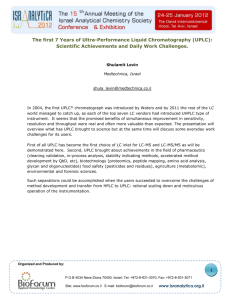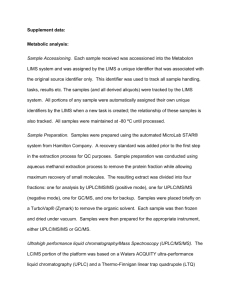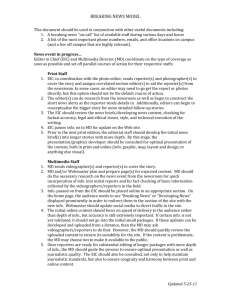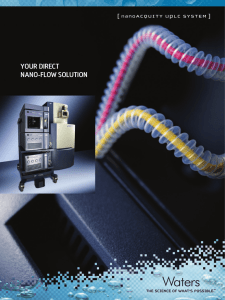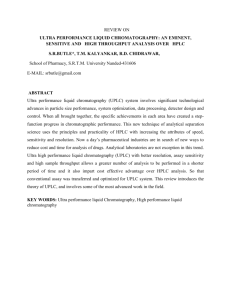Supporting information Coupling of Ultrafast LC with Mass
advertisement
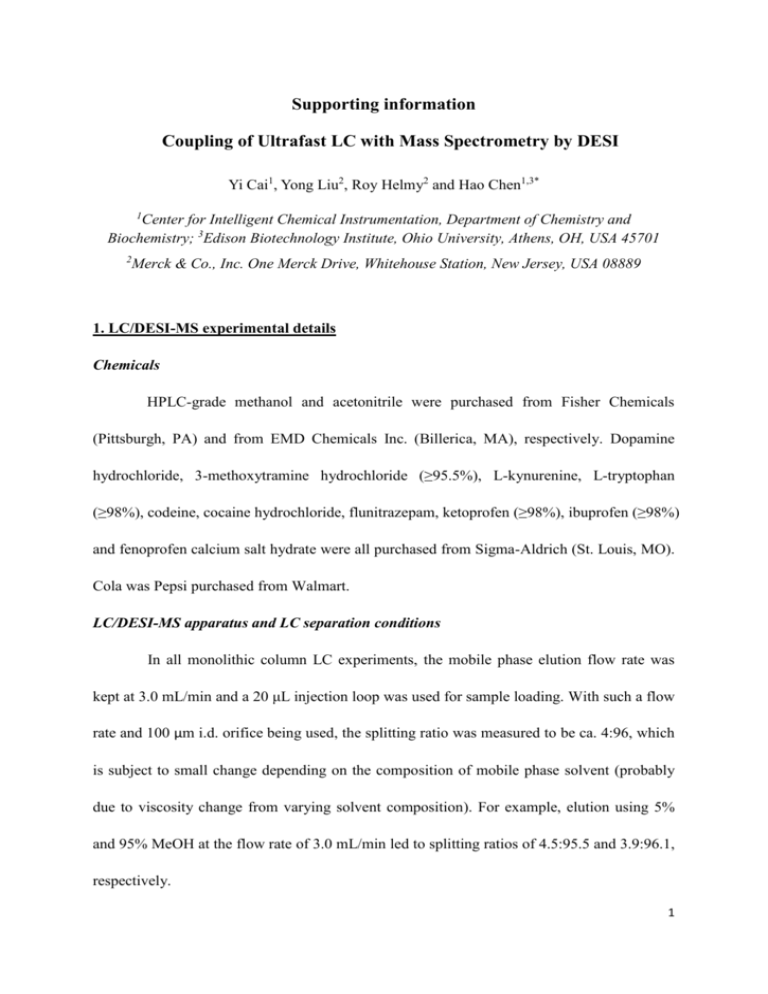
Supporting information Coupling of Ultrafast LC with Mass Spectrometry by DESI Yi Cai1, Yong Liu2, Roy Helmy2 and Hao Chen1,3* 1 Center for Intelligent Chemical Instrumentation, Department of Chemistry and Biochemistry; 3Edison Biotechnology Institute, Ohio University, Athens, OH, USA 45701 2 Merck & Co., Inc. One Merck Drive, Whitehouse Station, New Jersey, USA 08889 1. LC/DESI-MS experimental details Chemicals HPLC-grade methanol and acetonitrile were purchased from Fisher Chemicals (Pittsburgh, PA) and from EMD Chemicals Inc. (Billerica, MA), respectively. Dopamine hydrochloride, 3-methoxytramine hydrochloride (≥95.5%), L-kynurenine, L-tryptophan (≥98%), codeine, cocaine hydrochloride, flunitrazepam, ketoprofen (≥98%), ibuprofen (≥98%) and fenoprofen calcium salt hydrate were all purchased from Sigma-Aldrich (St. Louis, MO). Cola was Pepsi purchased from Walmart. LC/DESI-MS apparatus and LC separation conditions In all monolithic column LC experiments, the mobile phase elution flow rate was kept at 3.0 mL/min and a 20 μL injection loop was used for sample loading. With such a flow rate and 100 μm i.d. orifice being used, the splitting ratio was measured to be ca. 4:96, which is subject to small change depending on the composition of mobile phase solvent (probably due to viscosity change from varying solvent composition). For example, elution using 5% and 95% MeOH at the flow rate of 3.0 mL/min led to splitting ratios of 4.5:95.5 and 3.9:96.1, respectively. 1 Phenomenex Onyx Monolithic C18 column (100×4.6 mm) was employed for the separation of dopamine, 3-methoxytyramine, L-tryptophan and L-kynurenine in urine. The urine sample doped with these compounds was diluted 1:1 (v/v) with water to have the final concentration of 60 μM for each species, and then filtered with 0.2 μm Nylon Membrane for removing possible particulates before LC injection. Solvent A was 0.1% FA in H2O, and solvent B was 0.1% FA in ACN with elution program as such: 0-1min, 1% B; 1-3min, 1% B was ramped to 50%. For analysis of acidic anti-inflammatory drug mixture consisting of ketoprofen, fenoprofen and iburopfen (100 μM each), Phenomenex Onyx Monolithic C18 column (100×4.6 mm) was used again. The isocratic elution program was used H2O:MeOH:FA (30:70:0.05, by volume). For the UPLC experiments, ACQUITY UPLC® BEH C18 column (50×2.1 mm) was employed for the separation. A cola sample spiked with codeine, cocaine and flunitrazepam (150 μM each) was diluted 10 times by water before injection for UPLC/DESI-MS analysis. The mobile phase consisted of A: 0.1% FA in H2O and B: 0.1% FA in ACN. A linear gradient program ran from 23% to 90% solvent B in 3 min. With the mobile phase elution flow rate kept at 0.3 mL/min, the splitting ratio using the PEEK capillary tube carrying the 100 μm i.d. orifice was 1:1. For the high temperature (80 oC) separation of the drug mixture in cola, a gradient program held 23% B for 0.3 min then ramped to 90% B in 0.7 min with the flow rate of 1.0 mL/min. The splitting ratio was measured to be ca. 3:7. 2 2. Additional supporting data DESI spray probe N2 . . ... Monolithic or UPLC column Mixture sample DESI spray PEEK tubing UV IR NMR MS .... ... orifice Structure identification Outlet PEEK tubing Figure 1S. Apparatus of LC/DESI-MS using an orifice (i.d. 50 or 100 μm) drilled on PEEK capillary tubing for splitting LC/ESI-MS 100 a) EIC of dopamine NL: 2.40E4 Relative Abundance 0 100 b) EIC of 3-methoxytyramine NL: 1.77E5 0 100 c) EIC of L-kynurenine NL: 4.49E4 0 100 d) EIC of L-tryptophan NL: 3.53E4 0 0.0 0.2 0.4 0.6 0.8 1.0 1.2 1.4 1.6 1.8 2.0 Time (min) Figure 2S. EICs of a) dopamine (m/z 154), b) 3-methoxytyramine (m/z 168), c) L-kynurenine (m/z 209) and d) L-tryptophan (m/z 204) acquired by LC/ESI-MS 3 Table S1. Data showing LC/DESI-MS sensitivity for the urine sample analysis Injection Compounds concentrations ng to MS Signal/Noise (S/N)* 0.36 dopamine 450 ng/mL 5 0.20 3-methoxytyramine 250 ng/mL 7 0.50 L-tryptophan 620 ng/mL 10 L-kynureine 600 ng/mL 0.48 14 * The S/N was measured based on the ratio of the signal height (SIM signal in our experiment) to the standard deviation of blank signal height (noise). NMR, UV and IR of collected 3-methoxytyramine With 3-methoxytyramine collected at hand via MS-directed purification after LC separation, 1H NMR, UV and IR spectra of the collected explicitly were acquired, confirming its structure. In the 1H NMR spectrum, the methoxyl hydrogens -OCH3 give rise to a singlet peak at δ=3.861 ppm; CH2-CH2 hydrogens produce two triplet peaks at δ=3.141 ppm and at δ=2.865 pp, respectively. Three peaks at 6.695-6.846 ppm correspond to the three aromatic hydrogens. The maximum UV absorption of 3-methoxytyramine occurs at 282 nm. In the IR spectrum, major peaks observed include 3141 cm-1 (O-H stretch), 1525 cm-1 (aromatic ring C-C stretch), 1156 cm-1 (C-O stretch), 1278 cm-1(C-N stretch) and 799 cm-1 (N-H wag). Improving the recovery yield of the MS-directed purification In this study, with further reducing the orifice i.d. from 100 μm down to 50 μm, the splitting ratio of 0.9:99.1 (approximately 1:99) was obtained when the mobile phase elution flow rate was kept at 3.0 mL/min. The use of the smaller orifice would improve the sample collection yield up to 99% with only 1% sample being consumed for DESI-MS detection. Experiment was conducted to testify this hypothesis and the mixture of dopamine, 3-methoxytyramine, L-tryptophan and L-kynurenine was again chosen as the test sample. 4 Using the smaller orifice (50 μm i.d.), the four samples were successfully detected online by DESI-MS (data not shown). During the run of LC/DESI-MS, we collected 3-methoxytyramine from the PEEK capillary tube outlet and quantified the collection yield using UV absorption spectroscopy. LC with a UV detector (detection wavelength was selected at 210 nm) was used for the quantification of the DESI-MS-directed collection yield. 3-Methoxytyramine standard stock solutions were diluted into the standard solutions with five different concentrations (1, 2, 5, 10, and 20 μM), which were analyzed three times by LC/UV using the same LC separation condition described in text using monolithic C18 column to establish the calibration curve (Figure 3S). The collected 3-methoxytyramine solution was also injected for LC/UV analysis in triplicate measurements. The peak areas of collected 3-methoxytyramine solutions were brought into the regression equation of the calibration curve to get the concentrations of the collected 3-methoxytyramine solutions (Table 2S). Then, based on the collected volume, the moles of collected samples can be obtained to compare with the original amount of injected 3-methoxytyramine for LC separation to obtain the recovery yield of 98.6±0.6% on average (Table 2S). This collection yield is fairly close to the actual splitting ratio value of 99.1%. 5 100000 90000 y = 4381.8x - 2146.8 R² = 0.9963 80000 Peak Area 70000 60000 50000 40000 30000 20000 10000 0 0 5 10 15 20 25 3-MT Concentration (μM) Figure 3S. Calibration curves of 3-methoxytyramine (UV absorption peak area vs. 3-methoxytyramine solution concentration) Table 2S. Quantification results for the collection yield Replicate #1 Collected Concentration Volume (μM) (μL) 3-MT 3.295 360 Replicate #2 Yielda Concentration (μM) Collected Volume (μL) 98.85 % 3.299 360 Replicate #3 Yield 98.97 % Concentration (μM) Collected Volume (μL) 3.266 360 Yield 97.98 % Average Yield 98.6% 3-MT stands for “3-methoxytyramine”. UPLC/DESI-MS Relative Abundance 100 a) EIC of Codeine in Pepsi Absolute intensity : 5.10E3 0 100 b) EIC of Cocaine in Pepsi Absolute intensity : 7.34E3 0 100 0 c) EIC of Flunitrazepam in Pepsi Absolute intensity: 2.63E4 0.20 0.40 0.60 0.80 1.00 1.20 1.40 1.60 1.80 2.00 2.20 2.40 2.60 2.80 3.00 3.20 Time (min) Figure 4S. EICs of a) codeine (m/z 300), b) cocaine (m/z 304) and c) flunitrazepam (m/z 314) acquired by UPLC/DESI-MS 6 UPLC/ESI-MS Relative Abundance 100 a) EIC of Codeine in Pepsi Absolute intensity : 4.85E3 0 100 b) EIC of Cocaine in Pepsi Absolute intensity : 1.14E4 0 100 0 c) EIC of Flunitrazepam in Pepsi Absolute intensity : 2.41E4 0.20 0.40 0.60 0.80 1.00 1.20 1.40 1.60 1.80 2.00 2.20 2.40 2.60 2.80 3.00 3.20 Time (min) Figure 5S. EICs of a) codeine (m/z 300), b) cocaine (m/z 304) and c) flunitrazepam (m/z 314) acquired by UPLC/ESI-MS When elevated column temperature (80 oC) was used, the elution flow rate for UPLC separation was increased to 1.0 mL/min and the separation was completed in 45 s (Figure 3). In addition, the separated drugs were also online collected with the aid of DESI-MS detection and re-analysis of the collected drugs was performed using ESI-MS. The ESI-MS spectra shown in Figure 6S confirm that purified individual drugs were collected. 7 100 300 a) Re-analysis of codeine Relative Abundance 0 304 100 b) Re-analysis of cocaine 0 314. 100 0 295 c) Re-analysis of flunitrazepam 300 305 310 315 320 m/z Figure 6S. ESI-MS spectra of a) collected codeine, b) collected cocaine and c) collected flunitrazepam after high temperature UPLC separation 8
